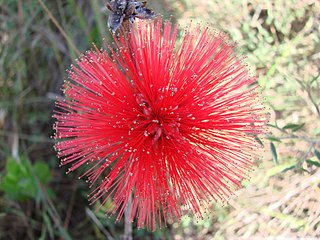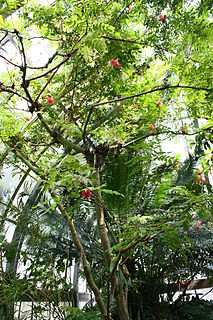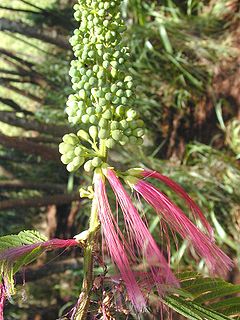
Calliandra is a genus of flowering plants in the pea family, Fabaceae, in the mimosoid clade of the subfamily Caesalpinioideae. It contains about 140 species that are native to tropical and subtropical regions of the Americas.

Calliandra brevipes, the pink powderpuff, is an attractive shrub with finely divided leaves and clusters of red powder-puff flowers. It is native to southeastern Brazil, Uruguay, and northern Argentina.

Calliandra eriophylla, commonly known as fairy duster, is a low spreading shrub which is native to deserts and arid grasslands in California, Arizona, New Mexico and Texas and Mexico.

Calliandra californica, the Baja fairy duster, is an evergreen, woody shrub which is native to Baja California, Mexico. In Spanish, the plant is also known vernacularly as tabardillo,zapotillo or chuparosa. The flowers, which appear in early summer, have clusters of red stamens. The shrub is usually between 0.6 and 1.8 metres in height and has bipinnate leaves. The leaves have been described as "fern-like." Leaves close at night time.
Calliandra bella is a species of flowering plants of the genus Calliandra in family Fabaceae.

Calliandra chilensis is a species of flowering plants of the genus Calliandra in the family Fabaceae.
Calliandra conferta is a species of flowering plants of the genus Calliandra in the family Fabaceae.
Calliandra cruegeri is a species of flowering plants of the genus Calliandra in the family Fabaceae.

Calliandra dysantha is a species of flowering plants of the genus Calliandra in the family Fabaceae. Is native to Brazil.
Calliandra foliolosa is a species of flowering plants of the genus Calliandra in the family Fabaceae.

Calliandra haematocephala is a species of flowering plants of the genus Calliandra in the family Fabaceae.
Calliandra haematomma is a species of flowering plants of the genus Calliandra in the family Fabaceae.

Calliandra houstoniana is a species of flowering plants of the genus Calliandra in the family Fabaceae.
Calliandra macrocalyx is a species of flowering plants of the genus Calliandra in the family Fabaceae.
Calliandra peninsularis is a species of flowering plants of the genus Calliandra in the family Fabaceae. It is endemic to Baja California Sur state in Mexico.
Calliandra physocalyx is a species of flowering plants of the genus Calliandra in the family Fabaceae, endemic to southwestern Mexico. It is a shrub with pink-and-white or pink-and-red flowers. Like other members of the genus Calliandra, the filaments of the stamens are long and colourful, in this case about 7.5 centimetres (3.0 in) long. The species was first scientifically described in 1988.

Calliandra surinamensis is a low branching evergreen tropical shrub that is named after Suriname, a country in northern South America. The plant usually has complexly branched multiple trunks and grows to a height of about 5 metres, although many sources suggest that it only attains a height of 3 metres. Left unpruned it grows long thin branches that eventually droop down onto the ground. The leaves close and droop from dusk until morning when they once again reopen. Calliandra surinamensis is said to contain lectins which are toxic to cancer cells, although more research is needed. Calliandra surinamensis contains three important compounds: myrectin which contains antioxidant and anti-inflammatory properties, lupeol which contains anti-inflammatory and anti-cancer properties, and ferulic acid which contains antimicrobial properties.
Calliandra elegans is a plant species in the genus Calliandra found in Brazil.

Calliandra calothyrsus is a small leguminous tree or large shrub in the family Fabaceae. It is native to the tropics of Central America where its typical habitat is wet tropical forests or seasonally dry forests with a dry season of four to seven months, when it may become deciduous. This tree grows to about 6 m (20 ft) and has pinnate compound leaves and flowers with a boss of prominent reddish-purple stamens. It is not very drought-tolerant and the above-ground parts are short-lived but the roots regularly resprout.

Platymma tweediei, often called the (Malaysian) fire snail, is the largest land snail in Peninsular Malaysia, living exclusively in the mountainous forests there. It is the only species in the genus Platymma. It is characterized by its black shell and orange to bright red foot.











